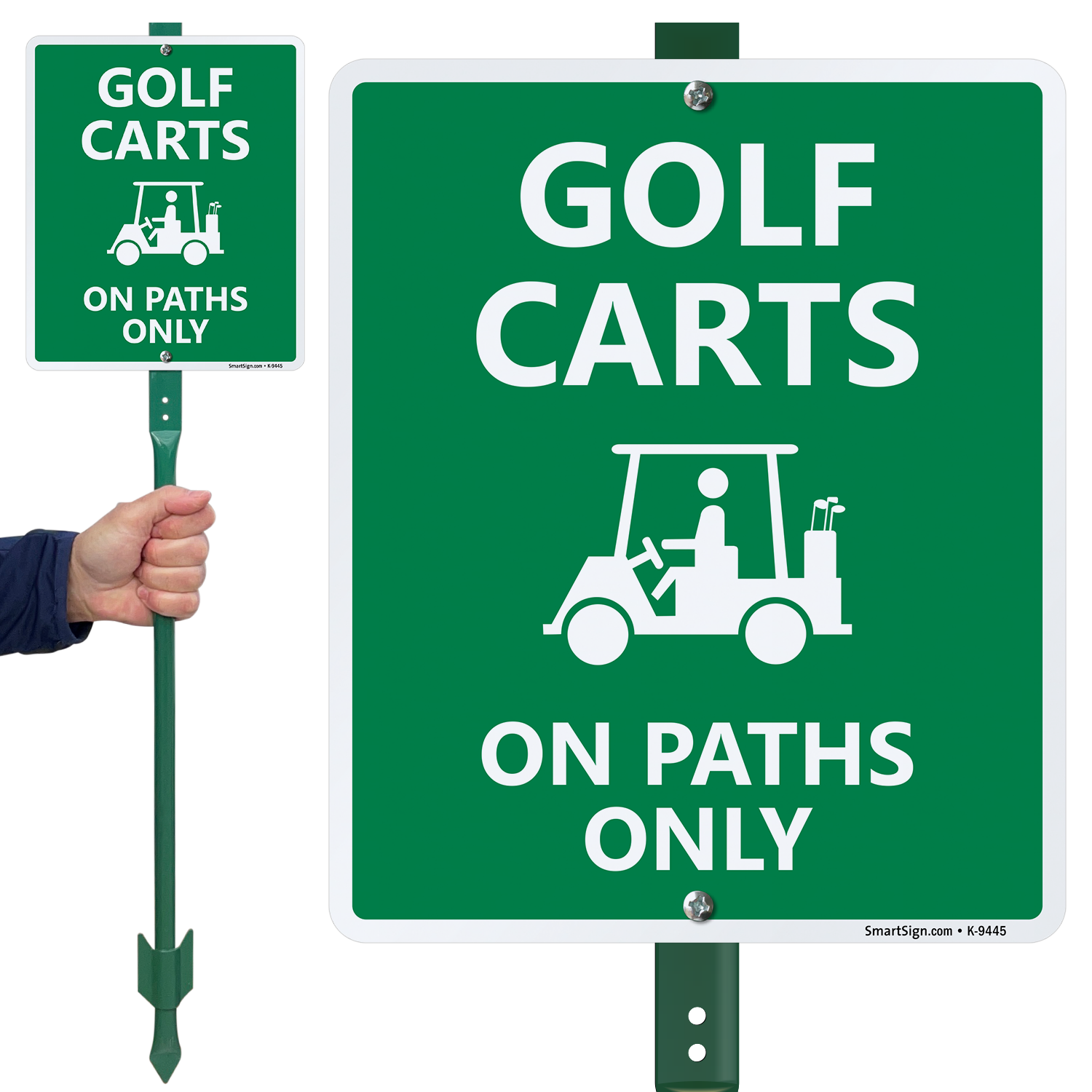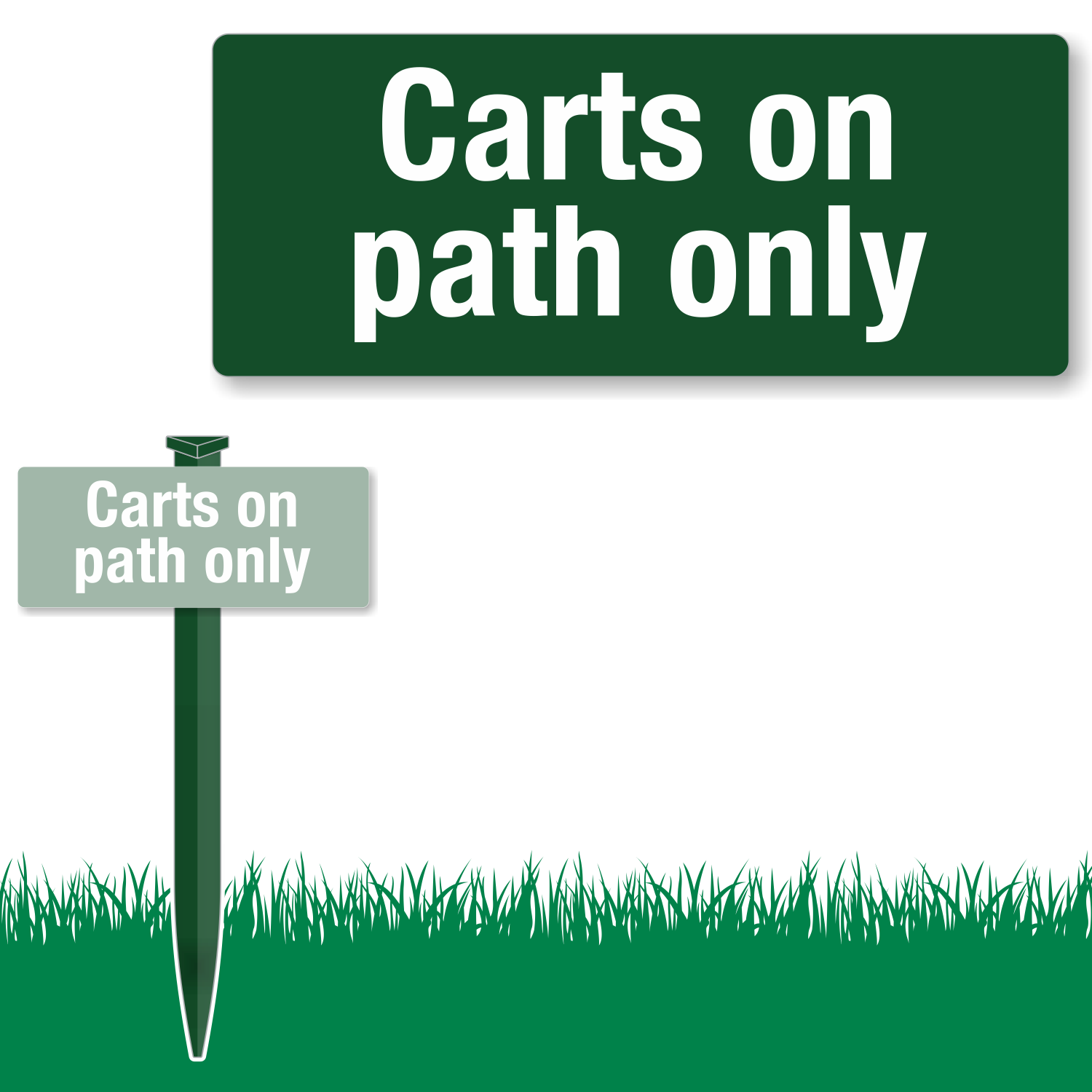Cart path only, a regulation commonly found on golf courses, mandates that golf carts remain confined to designated paths. This rule plays a crucial role in preserving the pristine condition of fairways and enhancing the overall golfing experience.
By restricting golf carts to designated paths, the rule helps prevent damage to the delicate turf, reduces soil compaction, and maintains the natural beauty of the course. Additionally, it promotes a more enjoyable and challenging game for golfers, as they must carefully plan their shots and navigate the course without the convenience of a cart on the fairway.
Definition of “Cart Path Only” Rule
:max_bytes(150000):strip_icc()/cart-path-only-584c38075f9b58a8cdd42134.jpg)
The “cart path only” rule in golf is a regulation that restricts the use of golf carts to designated paths on the golf course. This rule is typically enforced to protect the playing surfaces of the course, particularly the greens, fairways, and tee boxes, from damage caused by golf cart traffic.
By confining golf carts to designated paths, the rule helps to maintain the quality and integrity of the course for all players.
Rationale for Cart Path Only Rule
The rationale behind restricting golf carts to designated paths is primarily to prevent damage to the delicate playing surfaces of the golf course. Golf carts can cause significant damage to greens, fairways, and tee boxes if they are driven over these areas.
The weight of the cart can compact the soil, which can lead to poor drainage and make the surface more susceptible to damage from foot traffic. The tires of the cart can also tear up the grass, creating divots and bare spots.
By restricting golf carts to designated paths, the rule helps to protect these sensitive areas of the course.
Enforcement of Cart Path Only Rule
The “cart path only” rule is typically enforced on golf courses during periods of wet weather or when the course is particularly dry. During wet weather, the soil is more susceptible to damage from golf cart traffic, and the rule is enforced to prevent the course from becoming unplayable.
During dry weather, the rule is enforced to prevent the grass from being damaged by the tires of the golf carts. The rule is typically enforced by course marshals or other course officials, who may issue warnings or penalties to golfers who violate the rule.
Environmental Impact of Cart Path Restrictions

Limiting golf cart usage on fairways offers significant environmental benefits by preserving turf and reducing soil compaction. Unrestricted golf cart use can damage the delicate ecosystem of the golf course, impacting the health of the turf and the overall playing experience.
Preservation of Turf
- Golf carts exert pressure on the turf, causing it to thin out and become more susceptible to disease and damage.
- The “cart path only” rule confines golf carts to designated paths, preventing them from driving over fairways and greens, thus protecting the turf from excessive wear and tear.
Reduction of Soil Compaction
- Golf carts weigh several hundred pounds, and their weight can compact the soil beneath the turf.
- Compacted soil restricts water and nutrient absorption, hindering root growth and overall turf health.
- The “cart path only” rule limits the areas where golf carts can drive, reducing soil compaction and promoting healthier turf.
Potential Negative Impacts of Unrestricted Golf Cart Use
- Unrestricted golf cart use can lead to erosion, as the weight of the carts can displace soil and create ruts.
- Excessive cart traffic can also disturb wildlife and damage sensitive habitats within the golf course.
- Unrestricted golf cart use can increase noise pollution, affecting the tranquility of the playing environment.
Impact on Golf Play

The “cart path only” rule has a significant impact on the pace of play, convenience, and shot execution for golfers. Understanding the implications of this rule can help players adjust their strategies and maintain an enjoyable golfing experience.
Pace of Play
- Slower pace:Walking to and from the cart path can add time to each hole, potentially leading to delays and slower rounds.
- Reduced interruptions:By keeping carts on designated paths, the rule minimizes interruptions to other golfers, promoting smoother gameplay.
Convenience and Shot Execution
- Inconvenience:Walking long distances between the cart path and the ball can be tiring and inconvenient, especially in hot or wet weather.
- Shot execution:Carts provide stability and support, which can be beneficial for golfers with physical limitations or for executing certain shots, such as chips or putts.
- Course preservation:Keeping carts on designated paths helps protect fairways and greens from damage caused by excessive traffic.
Strategies for Adjusting to the Rule
To adjust to the “cart path only” rule, golfers can employ several strategies:
- Plan ahead:Determine the best routes to and from the cart path before each shot to minimize walking distance.
- Use a pull cart:A pull cart can provide a convenient way to transport clubs and avoid carrying them over long distances.
- Take advantage of shortcuts:Some courses may have designated shortcuts or paths that can reduce walking time.
- Stay hydrated:Walking long distances can lead to dehydration, so it’s important to stay hydrated by bringing plenty of water.
Enforcement and Compliance

Ensuring compliance with the “cart path only” rule is crucial for maintaining the integrity of the golf course and promoting responsible golfing practices. Various methods are employed to enforce this rule, each with its own advantages and challenges.
You also will receive the benefits of visiting west shore tahoe today.
One common method is through the use of physical barriers, such as ropes or stakes, which are placed along the cart paths to prevent golfers from driving their carts onto the fairways or greens. These barriers serve as a visible reminder of the rule and can be effective in deterring non-compliance.
However, they can also be inconvenient for golfers and may not always be sufficient to prevent determined individuals from violating the rule.
Monitoring and Enforcement
Another approach to enforcement is through monitoring by golf course staff or marshals. These individuals patrol the course and observe golfers’ behavior, intervening when they witness violations of the “cart path only” rule. This method can be effective in catching and penalizing non-compliant golfers, but it relies heavily on the vigilance and presence of the monitoring staff.
Additionally, it can be challenging to cover all areas of the course at all times, which may leave some areas vulnerable to violations.
Education and Awareness
In addition to physical barriers and monitoring, education and awareness campaigns play a vital role in promoting compliance with the “cart path only” rule. Golf courses can distribute educational materials, such as brochures or signs, that explain the importance of the rule and the potential consequences of non-compliance.
They can also conduct workshops or seminars to educate golfers about the environmental impact of driving carts on the course and the proper etiquette for using cart paths.
By raising awareness and understanding among golfers, golf courses can foster a sense of responsibility and encourage voluntary compliance with the rule. This approach can be particularly effective when combined with other enforcement methods, as it helps to create a culture of respect for the course and its environment.
Discover how cash car rentals atlanta has transformed methods in RELATED FIELD.
Consequences of Non-Compliance
Non-compliance with the “cart path only” rule can have various consequences for golfers. In many cases, golf courses will issue warnings or fines to individuals who are caught violating the rule. Repeated violations may result in more severe penalties, such as suspension or even revocation of playing privileges.
Beyond the direct consequences imposed by golf courses, non-compliance with the “cart path only” rule can also have negative impacts on the golf course itself. Driving carts on fairways and greens can damage the turf, create ruts and divots, and slow down the pace of play.
These consequences can detract from the enjoyment of the game for all golfers and increase the cost of maintaining the course.
You also can investigate more thoroughly about mexico city wedding to enhance your awareness in the field of mexico city wedding.
Recommendations for Promoting Compliance
To promote compliance with the “cart path only” rule, golf courses can implement a combination of the following recommendations:
- Establish clear and visible signage throughout the course, reminding golfers of the rule and the consequences of non-compliance.
- Use physical barriers, such as ropes or stakes, to prevent golfers from driving their carts onto restricted areas.
- Provide regular monitoring and enforcement by golf course staff or marshals to deter violations and penalize non-compliant golfers.
- Conduct educational campaigns to raise awareness about the importance of the rule and the environmental impact of driving carts on the course.
- Encourage golfers to report violations to course staff, fostering a sense of shared responsibility for maintaining the course.
By implementing these recommendations, golf courses can create a culture of compliance with the “cart path only” rule, protect the integrity of the course, and enhance the enjoyment of the game for all golfers.
Enhance your insight with the methods and methods of la rosa del monte.
Alternatives to Cart Path Restrictions: Cart Path Only

To preserve the integrity of fairways while accommodating the use of golf carts, alternative strategies have emerged.
One approach involves limiting the range of golf carts. By equipping carts with reduced battery capacity or installing boundary markers, golfers are encouraged to stay within designated driving areas.
In this topic, you find that travel door alarm is very useful.
Designated Driving Areas
- Golf courses can establish specific cart paths or zones where carts are permitted, reducing the impact on sensitive areas.
- This approach allows golfers to use carts for convenience while minimizing damage to the course.
Innovative Solutions, Cart path only
- Advanced GPS systems can be integrated into golf carts, providing real-time guidance and restricting access to restricted areas.
- Lightweight, eco-friendly golf carts can reduce soil compaction and turf damage, allowing for more sustainable cart usage.
Wrap-Up

In conclusion, the cart path only rule serves as a vital measure for protecting golf courses and ensuring a fair and enjoyable game for all golfers. By embracing this regulation, we can preserve the integrity of our fairways, enhance the challenge and strategy of the game, and promote a more sustainable approach to golf.
User Queries
Why is the cart path only rule important?
The cart path only rule is essential for preserving the condition of fairways, preventing soil compaction, and maintaining the natural beauty of golf courses.
How does the cart path only rule impact the pace of play?
The cart path only rule can potentially slow down the pace of play as golfers must walk to their balls instead of driving directly to them.
Are there any alternatives to the cart path only rule?
Alternative strategies include using golf carts with limited range or designated driving areas, as well as promoting the use of walking or shared carts.
:max_bytes(150000):strip_icc()/cart-path-only-584c38075f9b58a8cdd42134.jpg?w=1500&resize=1500,1000&ssl=1)